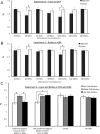Two critical and functionally distinct stages of face and body perception
- PMID: 23136426
- PMCID: PMC3752141
- DOI: 10.1523/JNEUROSCI.2624-12.2012
Two critical and functionally distinct stages of face and body perception
Abstract
Cortical regions that respond preferentially to particular object categories, such as faces and bodies, are essential for visual perception of these object categories. However, precisely when these regions play a causal role in recognition of their preferred categories is unclear. Here we addressed this question using transcranial magnetic stimulation (TMS). Across a series of experiments, TMS was delivered over the functionally localized right occipital face area (rOFA) or right extrastriate body area (rEBA) at different latencies, up to 150 ms, after stimulus onset while adult human participants performed delayed match-to-sample tasks on face and body stimuli. Results showed that TMS disrupted task performance during two temporally distinct time periods after stimulus onset, the first at 40/50 ms and the second at 100/110 ms. These two time periods exhibited functionally distinct patterns of impairment: TMS delivered during the early time period (at 40/50 ms) disrupted task performance for both preferred (faces at rOFA and bodies at rEBA) and nonpreferred (bodies at rOFA and faces at rEBA) categories. In contrast, TMS delivered during the later time period (at 100/110 ms) disrupted task performance for the preferred category only of each area (faces at rOFA and bodies at rEBA). These results indicate that category-selective cortical regions are critical for two functionally distinct stages of visual object recognition: an early, presumably preparatory stage that is not category selective occurring almost immediately after stimulus onset, followed by a later stage of category-specific perceptual processing.
Figures




Similar articles
-
Triple dissociation of faces, bodies, and objects in extrastriate cortex.Curr Biol. 2009 Feb 24;19(4):319-24. doi: 10.1016/j.cub.2009.01.007. Epub 2009 Feb 5. Curr Biol. 2009. PMID: 19200723
-
Facial expression recognition takes longer in the posterior superior temporal sulcus than in the occipital face area.J Neurosci. 2014 Jul 2;34(27):9173-7. doi: 10.1523/JNEUROSCI.5038-13.2014. J Neurosci. 2014. PMID: 24990937 Free PMC article.
-
Stimulation of category-selective brain areas modulates ERP to their preferred categories.Curr Biol. 2011 Nov 22;21(22):1894-9. doi: 10.1016/j.cub.2011.09.030. Epub 2011 Oct 27. Curr Biol. 2011. PMID: 22036183
-
Body selectivity in occipitotemporal cortex: Causal evidence.Neuropsychologia. 2016 Mar;83:138-148. doi: 10.1016/j.neuropsychologia.2015.05.033. Epub 2015 Jun 2. Neuropsychologia. 2016. PMID: 26044771 Review.
-
One object, two networks? Assessing the relationship between the face and body-selective regions in the primate visual system.Brain Struct Funct. 2022 May;227(4):1423-1438. doi: 10.1007/s00429-021-02420-7. Epub 2021 Nov 18. Brain Struct Funct. 2022. PMID: 34792643 Review.
Cited by
-
The causal role of the occipital face area (OFA) and lateral occipital (LO) cortex in symmetry perception.J Neurosci. 2015 Jan 14;35(2):731-8. doi: 10.1523/JNEUROSCI.3733-14.2015. J Neurosci. 2015. PMID: 25589766 Free PMC article.
-
Association of neuroimaging measures with facial emotional processing in healthy adults: a task fMRI study.Soc Cogn Affect Neurosci. 2024 Nov 18;19(1):nsae076. doi: 10.1093/scan/nsae076. Soc Cogn Affect Neurosci. 2024. PMID: 39420729 Free PMC article.
-
Using Transcranial Magnetic Stimulation to Test a Network Model of Perceptual Decision Making in the Human Brain.Front Hum Neurosci. 2020 Jan 24;14:4. doi: 10.3389/fnhum.2020.00004. eCollection 2020. Front Hum Neurosci. 2020. PMID: 32038206 Free PMC article.
-
Effects of online repetitive transcranial magnetic stimulation (rTMS) on cognitive processing: A meta-analysis and recommendations for future studies.Neurosci Biobehav Rev. 2019 Dec;107:47-58. doi: 10.1016/j.neubiorev.2019.08.018. Epub 2019 Aug 29. Neurosci Biobehav Rev. 2019. PMID: 31473301 Free PMC article. Review.
-
Different cortical dynamics in face and body perception: an MEG study.PLoS One. 2013 Sep 6;8(9):e71408. doi: 10.1371/journal.pone.0071408. eCollection 2013. PLoS One. 2013. PMID: 24039712 Free PMC article.
References
-
- Allison T, Puce A, Spencer DD, McCarthy G. Electrophysiological studies of human face perception. I. Potentials generated in occipito-temporal cortex by face and non-face stimuli. Cereb Cortex. 1999;9:415–430. - PubMed
-
- Corthout E, Hallett M, Cowey A. TMS-induced scotomata: time-based neglect. Clin Neurophysiol. 2007;118:1895–1898. - PubMed
-
- Cox RW, Jesmanowicz A. Real-time 3D image registration for functional MRI. Magn Reson Med. 1999;42:1014–1018. - PubMed
-
- Crouzet SM, Kirchner H, Thorpe SJ. Fast saccades toward faces: face detection in just 100 ms. J Vis. 2010;10:16.1–16.17. - PubMed
Publication types
MeSH terms
Grants and funding
LinkOut - more resources
Full Text Sources
